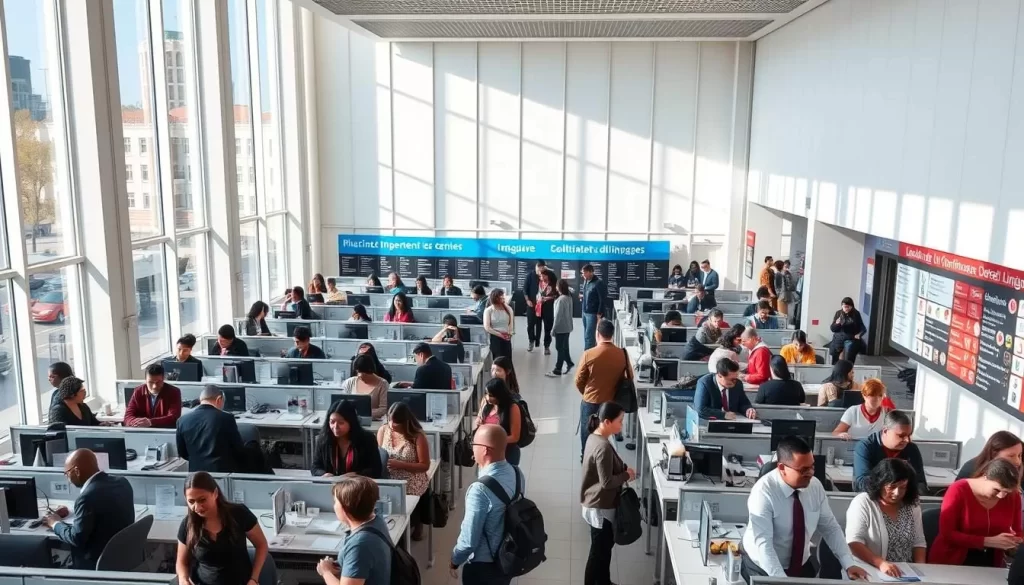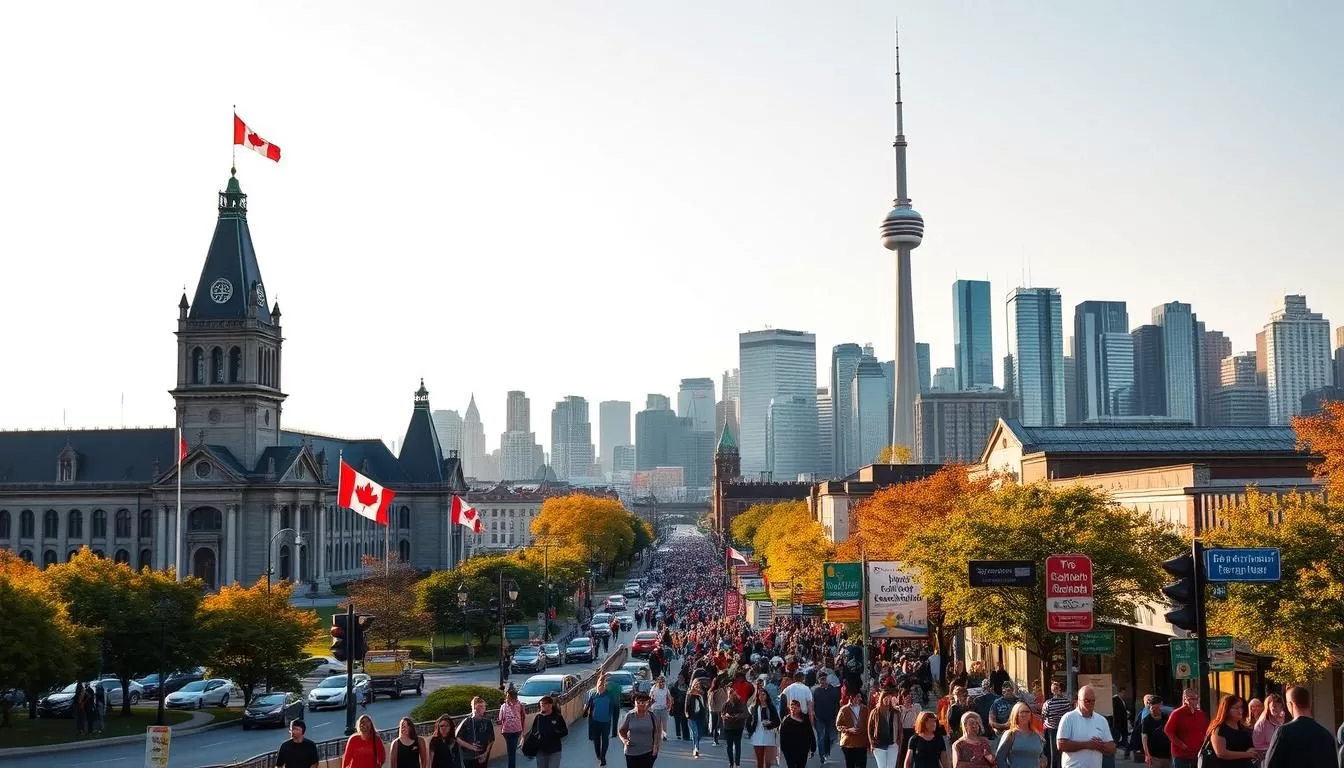Ontario is a vibrant province known for its rich cultural tapestry and linguistic diversity. With over 196 languages spoken, it’s a hub of multiculturalism. The province’s official languages, English and French, play a central role in shaping its identity. Did you know that 86% of Canadians speak English, while 30% speak French?
Beyond these two, languages like Mandarin, Punjabi, and Spanish are widely used, reflecting the province’s immigrant communities. This multilingual landscape isn’t just about communication—it’s a cornerstone of Ontario’s cultural and social fabric. For businesses and community services, understanding this diversity is key to success.
If you’re in the United States, you’ll find this fascinating, especially if you’re involved in cross-border ventures. Ontario’s linguistic diversity offers unique opportunities for collaboration and cultural exchange. Ready to explore more? Let’s dive into the historical, social, and practical aspects of this multilingual province.
Introduction to Ontario’s Linguistic Landscape
Step into a world where language shapes every interaction. With a population of over 14 million, this region is a melting pot of voices and cultures. From bustling cities to quiet neighborhoods, the way people communicate at home reflects their unique stories and heritage.
Historical growth has played a key role in this diversity. Over the years, waves of newcomers have brought their mother tongues, enriching the linguistic fabric. Today, you’ll hear everything from English and French to Mandarin and Punjabi in daily conversations.
At the person level, this diversity is even more striking. Families often blend languages, creating a unique mix of traditions and expressions. For example, a child might speak English at school, French with friends, and a family dialect at home.
“Language is the road map of a culture. It tells you where its people come from and where they are going.”
This rich linguistic portrait isn’t just about numbers—it’s about connection. Understanding these dynamics helps businesses, educators, and communities thrive. In the next sections, we’ll dive deeper into the historical, social, and practical aspects of this fascinating topic.
Ontario, Canada: Official and widely spoken languages
Public programs here thrive on bilingual and multilingual support. The province ensures that its residents have access to essential services in their preferred language. This commitment is backed by policies like the French Language Services Act, which guarantees French-speaking individuals access to government programs.
Language accessibility is a priority across the region. For example, public health announcements, legal documents, and educational materials are available in both English and French. This ensures that no one is left behind due to language barriers.
Here’s a quick look at how language services are utilized in everyday tasks:
| Service | Language Options |
|---|---|
| Healthcare | English, French, and interpreter services |
| Legal Support | Bilingual documentation and court interpreters |
| Education | Bilingual schools and language programs |
These efforts reflect the province’s dedication to inclusivity. By addressing diverse communication needs, it fosters a stronger, more connected community. Whether you’re accessing healthcare or navigating legal systems, language services are there to support you.
“Language is not just a tool for communication; it’s a bridge to understanding and inclusion.”
This bilingual structure isn’t just about policy—it’s about people. It ensures that everyone, regardless of their linguistic background, can fully participate in society. From government offices to local schools, the impact of these services is felt every day.
Historical Influences on Ontario’s Language Diversity
From ancient Indigenous roots to modern immigrant communities, language diversity here tells a story of resilience. Over 11,000 years ago, Paleo-Indians settled in this area, crossing the Bering land bridge and laying the foundation for its linguistic heritage.
Migration and settlement patterns have played a key role in shaping language use. For example, the Iroquois pushed related Iroquoian-speaking peoples out of southern Ontario by the early 1650s. Later, the 1763 Treaty of Paris marked a turning point, transferring French North American possessions to Britain and influencing the linguistic landscape.
Colonization and economic events also left their mark. From 1783 to 1796, loyalist refugees were granted land, boosting the English-speaking population. By 1851, waves of immigration had doubled the population, with English speakers surpassing French speakers for the first time.
Today, this area reflects a vibrant cultural mosaic. The influence of various communities, from Indigenous nations to immigrant groups, has shaped its regional culture. Historical choices, like the establishment of bilingual policies, continue to impact its linguistic identity.
Understanding this evolution helps you appreciate why this region’s linguistic culture is unique. It’s a blend of history, community, and resilience that continues to thrive.
English and French: The Cornerstones of Communication
Communication in this region is built on two pillars: English and French. These languages are not just tools for interaction—they are deeply woven into the fabric of daily life. Whether you’re navigating business, education, or government services, understanding their roles is essential.
English as the Dominant Language
English is the primary language for most residents. It dominates business, media, and government communications. Over 86% of the population uses it daily, making it the go-to language for most interactions.
This dominance reflects the country’s historical ties to English-speaking nations. From colonial roots to modern globalization, English has evolved into a unifying force. It’s also the preferred language for many immigrant communities, helping them integrate into society.
French Language and Its Unique Role
French holds a special place in this region’s identity. It’s not just a language—it’s a symbol of cultural heritage. The history of French here dates back centuries, and today, it’s protected by policies like the Official Languages Act.
French is particularly vital in preserving local traditions. It’s widely used in education, arts, and community events. For many, it’s a way to connect with their roots and celebrate their identity.
“Language is the bridge between the past and the future.”
Bilingual policies ensure both languages thrive. For example, government services are available in English and French, reflecting the country’s commitment to inclusivity. This dual-language mandate has shaped everything from education to public signage.
The influence of immigrant communities has also enriched both languages. Over time, they’ve introduced new expressions and cultural nuances, adding depth to the linguistic landscape.
Understanding the roles of English and French helps you appreciate the region’s unique character. These languages are more than just words—they’re a reflection of its history, diversity, and shared values.
Indigenous Languages in Ontario and Their Cultural Significance
Indigenous languages hold a profound cultural significance that transcends generations. They are more than just a means of communication—they are a vital link to heritage, identity, and community. Over 70 distinct Indigenous languages are still spoken today, each carrying unique stories and traditions.
Preserving Indigenous Tongues
Efforts to preserve these languages are gaining momentum. Community programs and education initiatives play a crucial role in revitalizing Indigenous tongues. For example, schools are increasingly integrating Indigenous language classes, ensuring younger generations stay connected to their roots.
Local initiatives are also making a difference. Programs like language immersion camps and cultural workshops help keep these languages alive. The Algonquian language family, with over 144,000 speakers, is a testament to these efforts.
“Language is the heartbeat of our culture. It keeps our traditions alive and our communities strong.”
Government support has been instrumental in this process. Policies aimed at revitalizing Indigenous languages ensure they remain a vibrant part of the linguistic landscape. For instance, Cree languages and Inuktitut are among the most widely spoken, thanks to these efforts.
Integrating Indigenous language education into schools is another critical step. It not only preserves these languages but also fosters a deeper understanding of cultural diversity. This approach ensures that Indigenous languages continue to thrive alongside language english and other dominant tongues.
Indigenous languages contribute significantly to the broader language spoken landscape. They remind us that linguistic diversity goes beyond just English and French. By supporting these languages, we honor the rich cultural tapestry they represent.
The Rise of Immigrant Languages and Their Impact
Immigrant communities have reshaped the linguistic landscape, bringing a mosaic of new voices and traditions. Recent census data shows that 72.5% of immigrants report a mother tongue other than English or French, highlighting the growing diversity. This shift has made multilingualism a key part of everyday life.

Popular Immigrant Languages
Languages like Mandarin, Punjabi, and Spanish are now widely spoken, reflecting the cultural roots of immigrant communities. Over 76.4% of immigrants know more than one language, compared to 27.5% of native-born individuals. This multilingual ability enriches communication and fosters cultural exchange.
Cultural Enrichment Through Diversity
Immigrant languages have not only diversified the linguistic profile but also influenced local culture. Festivals, food, and art now reflect this vibrant mix. For example, Mandarin speakers often bring traditions that enrich community events, making them more inclusive.
This diversity also impacts government services. Policies now ensure that essential information is available in multiple languages. This inclusivity helps everyone feel connected and supported.
| Language | Community Impact |
|---|---|
| Mandarin | Enriches cultural festivals and business communication |
| Punjabi | Strengthens community bonds through shared traditions |
| Spanish | Enhances accessibility in healthcare and education |
Immigrant languages are now a vital part of the region’s identity. They remind us that diversity is not just about numbers—it’s about connection and shared experiences.
Role of Immigration in Shaping Ontario’s Language Landscape
Immigration has played a pivotal role in shaping the linguistic fabric of this region. Over the decades, waves of newcomers have brought their native tongues, enriching the land with a vibrant mix of languages. According to the 2021 Census, 23.0% of the population were or had ever been landed immigrants or permanent residents, the highest proportion since Confederation.
From 2016 to 2021, over 1.3 million new immigrants settled permanently, introducing languages like Mandarin, Punjabi, and Spanish. This influx has not only diversified the linguistic profile but also influenced public information and services. For example, government programs now provide resources in multiple languages to meet the needs of a multicultural population.
Here’s a closer look at how immigration has transformed the language landscape:
| Aspect | Impact |
|---|---|
| Language Diversity | Increased variety of languages spoken |
| Public Services | Multilingual resources and support |
| Cultural Exchange | Enhanced understanding through shared traditions |
Government initiatives have adapted to these changes. Programs like the Local Immigration Partnerships (LIPs) operate in 87 cities, regions, and remote communities, ensuring newcomers have access to essential knowledge and support. These efforts reflect a commitment to inclusivity and cultural integration.
“Immigration doesn’t just bring people—it brings stories, traditions, and languages that enrich our communities.”
Historical trends also play a role. The share of recent immigrants from Europe fell from 61.6% in 1971 to 10.1% in 2021, while those from Asia rose to 62.0%. This shift has redefined the linguistic identity of the region, making it a hub of global cultures.
These changes offer significant benefits. They foster cultural understanding, improve service delivery, and create a more inclusive society. By embracing this diversity, the region continues to thrive as a mosaic of voices and traditions.
Multilingualism in Everyday Life and Business
In both homes and workplaces, speaking multiple languages is a common practice. This ability fosters deeper connections and opens doors to new opportunities. Whether you’re at a family dinner or in a boardroom meeting, multilingualism shapes daily interactions.
Many businesses thrive by supporting multilingual customer service. For example, companies in British Columbia often hire staff fluent in Mandarin, Punjabi, and Spanish to better serve diverse communities. This approach not only improves customer satisfaction but also strengthens brand loyalty.
Bilingual and multilingual workplaces are known to foster innovation. Employees who speak more than one language bring unique perspectives, enhancing problem-solving and creativity. In French-speaking communities, this dynamic is particularly evident, as bilingualism is deeply embedded in the culture.
Language diversity is also celebrated by First Nations communities. Their efforts to preserve Indigenous languages enrich the cultural fabric of the region. Similarly, French-speaking communities continue to honor their heritage through language, ensuring it remains a vital part of their identity.
Trends in multilingualism here mirror those in British Columbia, where language diversity is a key driver of economic and social growth. Both regions recognize the value of fostering inclusive environments where multiple languages are embraced.
In a global marketplace, multilingual capabilities provide a competitive edge. Companies with employees fluent in multiple languages can navigate international negotiations more effectively, reducing misunderstandings and building trust.
| Benefit | Impact |
|---|---|
| Customer Service | Improved satisfaction and loyalty |
| Workplace Innovation | Enhanced creativity and problem-solving |
| Global Competitiveness | Stronger international business relationships |
Everyday communication also benefits from multilingual integration. From media to local dialogues, the ability to speak multiple languages bridges gaps and fosters understanding. This inclusivity strengthens communities and enriches personal relationships.
“Language is the key to unlocking new opportunities and building stronger connections.”
By embracing multilingualism, you can tap into its transformative power. Whether in your personal life or professional endeavors, it’s a skill that opens doors and creates lasting impact.
Implications for Government Services and Community Support
Navigating government services in a multilingual setting requires thoughtful planning and inclusive policies. The Official Languages Act (OLA), first enacted in 1969 and updated in 2023, ensures that federal institutions deliver services in both English and French. This commitment reflects a century-long tradition of accommodating the French language in governmental frameworks.

Government agencies must offer services in multiple languages to meet the needs of diverse communities. For example, the 2023 legislative amendments introduced the Use of French in Federally Regulated Private Businesses Act, expanding linguistic obligations. This ensures that everyone, regardless of their linguistic background, can access essential services.
The media plays a crucial role in supporting multilingual information dissemination. Public health announcements, legal documents, and educational materials are available in both English and French, ensuring inclusivity. This approach helps bridge communication gaps and fosters community unity.
Community support programs also address language barriers effectively. Initiatives like language immersion camps and cultural workshops help newcomers integrate while preserving their heritage. These programs not only support individuals but also enrich the broader community.
“Language is the bridge to understanding and inclusion, ensuring no one is left behind.”
Here’s how language diversity improves service efficiency in public institutions:
| Service | Language Options |
|---|---|
| Healthcare | English, French, and interpreter services |
| Legal Support | Bilingual documentation and court interpreters |
| Education | Bilingual schools and language programs |
Inclusive communication channels are vital for fostering community unity. The media ensures that information reaches everyone, regardless of their preferred language. This approach strengthens trust and engagement within diverse communities.
For more details on how these initiatives are implemented, explore the Action Plan for Official Languages 2023-2028. This plan highlights the government’s commitment to promoting equality and inclusivity through language support.
Education and Language Programs in Ontario
Education in this region bridges cultures through bilingual and Indigenous language programs. These initiatives ensure that every student, regardless of background, has access to quality learning experiences. By integrating multiple languages into the curriculum, schools prepare the next generation for a multicultural future.
Bilingual Education Initiatives
Bilingual education is a cornerstone of the educational system. Schools offer programs that support both English and French learners, ensuring students develop fluency in both languages. These programs adapt to meet the needs of a diverse generation, fostering inclusivity and academic success.
Government-supported initiatives play a key role. For example, the program of study in accredited schools includes tailored curricula for bilingual learners. This approach helps students excel academically while preserving their cultural identity.
Indigenous Language Revitalization in Schools
Efforts to revitalize Indigenous languages are gaining momentum. Schools now integrate Indigenous language classes into their curricula, ensuring younger generations stay connected to their heritage. These classes are more than just language lessons—they are a celebration of culture and history.
Community partnerships enhance these efforts. Programs like language immersion camps and cultural workshops help preserve Indigenous languages. These initiatives not only benefit students but also enrich the broader community.
Here’s a quick overview of how these programs impact education:
| Program | Impact |
|---|---|
| Bilingual Education | Enhances fluency in English and French |
| Indigenous Language Classes | Preserves cultural heritage |
| Community Workshops | Strengthens community bonds |
These educational approaches ensure that every student thrives. By embracing bilingualism and Indigenous languages, schools create a more inclusive and culturally rich learning environment. For more insights, explore the English language learners policy.
Language Data Insights from the 2021 Census
The 2021 Census reveals fascinating insights into the linguistic diversity shaping communities today. Over 20% of residents report a mother tongue other than English or French, marking a record high. This trend highlights the growing influence of immigrant communities and their languages.
English remains the dominant language, with 54.9% of the population reporting it as their single mother tongue. French follows at 19.6%, reflecting its cultural significance. Meanwhile, 21.4% of residents speak a non-official language at home, up from 21.1% in 2016.
Mandarin, Punjabi, and Spanish are among the most common non-official languages. For example, Mandarin speakers number 679,000, while Punjabi speakers total 667,000. These figures underscore the vibrant multilingual landscape.
Bilingualism is another key highlight. Approximately 18% of residents can speak both English and French, with Quebec leading at 46.4%. This reflects ongoing efforts to preserve linguistic heritage while fostering inclusivity.
“Language diversity is not just a statistic—it’s a reflection of our shared history and future.”
Indigenous languages also play a vital role. Over 189,000 people report an Indigenous mother tongue, with Cree languages and Inuktitut being the most common. These numbers highlight the importance of revitalization efforts in preserving cultural identity.
For more detailed insights, explore the 2021 Census data on language diversity. This resource provides a comprehensive look at how language shapes communities and informs policies.
Business Implications of Ontario’s Language Diversity
Businesses thrive when they embrace the linguistic diversity of their communities. Over 200 languages are spoken daily here, reflecting a rich cultural tapestry. This diversity isn’t just a statistic—it’s a competitive advantage for companies that adapt.

Understanding the mother tongue of your customers can transform your marketing strategy. For example, companies like Tim Hortons and Airbnb have successfully tailored their messages to resonate with diverse audiences. Tim Hortons offers multilingual menus, while Airbnb provides localized content in over 60 languages.
Minority language communities significantly influence consumer behavior. By addressing their unique needs, businesses can build trust and loyalty. For instance, Punjabi-speaking communities often prefer services in their native tongue, creating opportunities for targeted marketing.
“Language is the bridge to customer loyalty. When you speak their language, you speak to their heart.”
Here’s how businesses can leverage language diversity:
| Strategy | Impact |
|---|---|
| Multilingual Customer Service | Enhances customer satisfaction and loyalty |
| Localized Marketing | Builds trust with minority communities |
| Cultural Sensitivity Training | Improves employee-customer interactions |
Adapting to this diversity opens up new market segments. For example, Shopify’s platform is used in 175 countries, demonstrating the global potential of multilingual strategies. By understanding the mother tongue and communication preferences of your audience, you can create a more inclusive and effective business model.
For businesses aiming to thrive in this environment, the Ontario Culture Strategy offers valuable insights. It highlights the importance of cultural engagement and inclusion, ensuring that all voices are heard and respected.
By embracing linguistic diversity, you not only enhance your brand’s reach but also contribute to a more inclusive society. Start today by integrating these strategies into your business plan.
Strategies for Localizing Content to Reach Diverse Communities
Connecting with diverse audiences requires more than just translation—it demands cultural understanding. In today’s global market, businesses must adapt their messaging to resonate with different cultural groups. This process, known as localization, ensures your content feels relevant and authentic to your audience.
Start by identifying the demand for specific languages in your target community. For example, Netflix tailors its content for regions like the united states, offering subtitles and dubbing in multiple languages. This approach not only broadens their reach but also enhances viewer satisfaction.
- Research your audience: Understand their language preferences, cultural values, and communication styles.
- Adapt your messaging: Use local dialects and idioms to make your content relatable.
- Update regularly: Keep your website and marketing materials current to align with evolving demand.
Cultural nuances play a significant role in shaping communication. For instance, Tim Hortons offers multilingual menus to cater to diverse communities. This attention to detail builds trust and loyalty among customers.
“Localization is not just about language—it’s about creating a connection that feels personal and meaningful.”
Aligning your strategies with government and community standards is equally important. In the united states, businesses often follow guidelines to ensure inclusivity. This alignment not only meets legal requirements but also fosters goodwill.
Here’s how successful companies tailor their messaging year after year:
| Strategy | Impact |
|---|---|
| Multilingual Customer Support | Enhances user experience and satisfaction |
| Cultural Sensitivity Training | Improves employee-customer interactions |
| Localized Marketing Campaigns | Builds brand loyalty in diverse markets |
By embracing these strategies, you can create content that resonates with your audience on a deeper level. The lasting benefits of culturally aware content include stronger relationships, increased engagement, and sustained growth in today’s global market.
Canadian French vs. European French in Ontario
Canadian French and European French may share roots, but their evolution has created distinct identities. While both dialects stem from the same language, centuries of separation have led to unique vocabulary, pronunciation, and cultural nuances.
One key difference lies in vocabulary. For example, “parking” in European French is “stationnement” in Canadian French. Similarly, “car” is “une voiture” in Europe but “un char” in Canada. These variations can lead to confusion if not addressed in translations.
Pronunciation also sets the two apart. Canadian French often retains a more nasal quality and preserves older vowel sounds, while European French has evolved differently. This can make conversations between speakers of the two dialects challenging.
Why do these differences matter? In business and government communications, understanding these nuances is crucial. Miscommunication can lead to misunderstandings, impacting customer satisfaction and operational efficiency.
For instance, a marketing campaign using European French terms might not resonate with Canadian audiences. Similarly, government documents translated without considering local dialects could alienate certain communities.
Here’s how the rate of Canadian French usage varies across regions:
| Region | Francophone Population |
|---|---|
| Ontario | 4.4% |
| Quebec | 85% |
| New Brunswick | 33% |
Adapting translations to fit cultural nuances is essential. For example, using “magasiner” (Canadian French) instead of “faire du shopping” (European French) can make your message more relatable.
“Language is not just about words—it’s about connecting with your audience on a deeper level.”
Respecting these differences offers financial and branding benefits. Companies that localize their content see higher engagement and customer loyalty. It’s a small investment with significant returns.
In Ontario, where francophones make up 4.4% of the population, tailoring your approach can make a big difference. Whether you’re in business or government, understanding these linguistic subtleties ensures your message is clear and effective.
Practical Tips for Effective Communication and Translation
Effective communication and translation are essential skills in today’s globalized world. Whether you’re an artist, marketer, or business owner, tailoring your message to cultural nuances can make a significant difference. Understanding local customs and preferences ensures your content resonates with diverse audiences.

Start by researching your target audience. For example, Netflix excels at localization by offering subtitles and dubbing in multiple languages, enhancing viewer satisfaction. This approach not only broadens their reach but also builds trust with their audience.
Working with professional translators who understand regional differences is crucial. In New Brunswick, where bilingualism is prevalent, translators ensure messages are culturally relevant and accurate. This attention to detail fosters stronger connections with local communities.
Focus groups and feedback from diverse groups can refine your messaging. For instance, Tim Hortons uses multilingual menus to cater to various cultural preferences. This strategy not only improves customer satisfaction but also strengthens brand loyalty.
Adapting tone, idioms, and marketing copy to suit group preferences is equally important. Airbnb’s localized content in over 60 languages demonstrates how cultural sensitivity can enhance user experience. Their approach ensures that every guest feels welcomed and understood.
“Language is the bridge to customer loyalty. When you speak their language, you speak to their heart.”
Authenticity and local relevance are key to connecting with your audience. In New Brunswick, businesses that embrace bilingualism and cultural diversity see higher engagement rates. This strategy not only improves communication but also fosters long-term relationships.
By implementing these practical tips, you can create content that resonates deeply with your audience. Whether you’re targeting a specific group or a broader demographic, understanding cultural nuances ensures your message is clear, relatable, and impactful.
Conclusion
Exploring the linguistic landscape reveals a dynamic interplay of cultures and traditions. The city thrives on its rich variety of languages, shaped by historical influences and immigrant contributions. Indigenous languages add depth, while bilingual policies ensure inclusivity in education and community services.
For businesses, understanding this diversity is key to success. Localization strategies help connect with diverse audiences, fostering trust and loyalty. Embracing multilingualism not only enhances communication but also strengthens community bonds.
Ready to dive deeper? Explore how linguistic diversity shapes every aspect of life. For expert support in translation and localization, consider reaching out to professionals like Laoret. Together, we can build bridges across languages and cultures.
The above is subject to change.
Check back often to TRAVEL.COM for the latest travel tips and deals.






